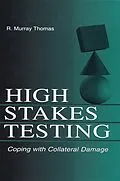The federal government's No Child Left Behind Act has thrust high-stakes testing - its goals, methods, and consequences - into the educational limelight. The four-fold purpose of this book is to: describe the nature of high-stakes testing; identify types of collateral damage that have attended the testing programs; analyze methods different groups of people have chosen for coping with the damage and suggest lessons to be learned from the high-stakes-testing experience.
The six groups of people whose coping strategies are inspected include: politicians and their staffs; educational administrators and their staffs; parents and the public; test makers and test administrators; teachers and students. Importantly, the author avoids aligning himself with the test-bashing rhetoric of those who oppose high-stakes testing, especially the No Child Left Behind Act.
Key features of this outstanding new book include:
- illustrative cases. The book offers more than 350 cases of collateral damage from high-stakes testing--and people's coping strategies--as reported in newspapers over the 2002-2004 period.
- background perspectives. Part I examines the influence of high-stakes testing on: 1) what schools teach; 2) how student progress is evaluated; 3) how achievement standards are set; and 4) how test results are used.
- participant responses. Part II, which is the heart of the book, devotes a separate chapter to the coping strategies of each of the major participants in the high-stakes testing movement: politicians and their staffs, educational administrators and their staffs, parents and the public, test-makers and test-givers, teachers, and students.
- summary chapter. The last chapter (Lessons to Learn) offers suggestions for minimizing collateral damage by adopting alternative approaches not used in the creation of our current high-stakes testing programs, particularly the federal government's No Child Left Behind Act.
This book is appropriate for any of the following audiences: students taking evaluation or administration courses in schools of education, inservice administrators and teachers, policy makers, and those members of the general public who are concerned about the fate of schooling in America.
Autorentext
R. Murray Thomas
Zusammenfassung
Social Motivation, Justice, and the Moral Emotions proposes an attribution theory of interpersonal or social motivation that distinguishes between the role of thinking and feeling in determining action. The place of this theory within the larger fields of motivation and attributional analyses is explored. It features new thoughts concerning social motivation on such topics as help giving, aggression, achievement evaluation, compliance to commit a transgression, as well as new contributions to the understanding of social justice. Included also is material on moral emotions, with discussions of admiration, contempt, envy, gratitude, and other affects not considered in Professor Weiner's prior work. The text also contains previously unexamined topics regarding social inferences of arrogance and modesty.Divided into five chapters, this book:*considers the logical development and structure of a proposed theory of social motivation and justice;*reviews meta-analytic tests of the theory within the contexts of help giving and aggression and examines issues related to cultural and individual differences; *focuses on moral emotions including an analysis of admiration, envy, gratitude, jealousy, scorn, and others;*discusses conditions where reward decreases motivation while punishment augments strivings; and*provides applications that are beneficial in the classroom, in therapy, and in training programs.This book appeals to practicing and research psychologists and advanced students in social, educational, personality, political/legal, health, and clinical psychology. It will also serve as a supplement in courses on motivational psychology, emotion and motivation, altruism and/or pro-social behavior, aggression, social judgment, and morality. Also included is the raw material for 13 experiments relating to core predictions of the proposed attribution theory.
Inhalt
Contents: Preface. The Nature of Collateral Damage. Part I: Tasks of the Testing Game. What Should the Schools Teach? What Should the Schools Evaluate and How? How Should Achievement Standards Be Set? How Should Test Results Be Used? Part II: The Testing Game's Players. Politicians and Their Staffs. Educational Administrators and Their Staffs. The Public and Parents. Test-Makers and Test-Givers. Teachers. Students. Lessons to Learn.
